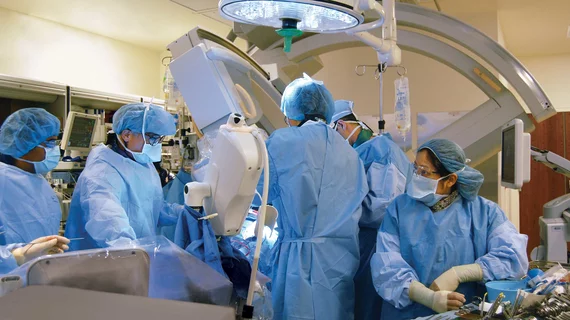Prosthesis-patient mismatch after TAVR makes minimal impact on long-term outcomes
Prosthesis-patient mismatch (PPM) after transcatheter aortic valve replacement (TAVR) makes a small impact on long-term patient outcomes, according to new research published in American Heart Journal.[1] In fact, the study’s authors described the clinical significance of predicted PPM as “negligible.”
“PPM occurs when the implanted valve prosthesis is too small in relation to the patient's body surface area,” wrote first author Emma Ellfors, MD, with the department of molecular medicine and surgery at Sweden’s Karolinska Institute, and colleagues. “PPM can be either measured, most often using echocardiography, or predicted using existing reference values for the effective orifice area (EOA) for each valve type and size. PPM after SAVR has been associated with worse hemodynamic function, less regression of left ventricular hypertrophy, and a higher risk of heart failure hospitalization and all-cause mortality. However, research to date has yielded varying results regarding the impact of PPM after TAVR.”
Ellfors et al. examined data from more than 8,000 TAVR patients included in the SWEDEHEART registry. All patients underwent TAVR from 2008 to 2022 in Sweden. Valves included in the analysis were distributed by Medtronic, Edwards Lifesciences, Boston Scientific, Abbott or Meril Life Sciences.
The mean patient age was 81 years old, 54% were men and 7% had moderate to severe PPM. Patients with PPM tended to be slightly younger—mean ages of 81 vs. 79 years old—and were more frequently male than female. Patients without PPM, on the other hand, had lower box mass indexes, lower ventricular ejection fraction and were less likely to present with diabetes.
Reviewing the SWEDEHEART data, including a mean follow-up time of three years and maximum follow-up time of 14 years, the researchers found that 35% of patients died. After regression standardization, however, the rates of long-term mortality were comparable between patients with and without predicted PPM. The same was also true for heart failure hospitalization and aortic valve reintervention rates. The numbers evened out after regression standardization, making it hard to detect much of a difference between the two groups.
“Separate analyses were performed in men and women, in patients with balloon-expandable valves, in patients who underwent periprocedural post-dilatation, and in patients who underwent TAVR before and after 2018,” the authors added. “The results of all subgroup analyses were consistent with those of the main analyses.”
The group did note, however, that they expected TAVR to be used more and more in young patients as time goes on. With this in mind, they emphasized the importance of tracking PPM-related outcomes with additional research.
“Although we found no association between predicted PPM and clinical outcomes in our study, younger patients with a longer life expectancy might be more susceptible to the negative outcomes previously associated with PPM because such patients have a longer time to develop these complications,” they concluded. “Thus, further studies involving younger and more low-risk patients are needed to confirm our findings.”
Read the full study here.

